
|
Deaths Scenes 1943-1945 |
| Film Title/Year and Description | ||
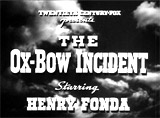
|
In this dramatic western, the three accused and suspected men were led to the base of a gnarled tree for a hanging, where three nooses had been hanging prominently and ominously throughout the previous sequence. A reluctant Gerald Tetley (William Eythe) was ordered to participate by his father Major Tetley (Frank Conroy):
As the hands of the three suspects were tied behind their backs, one of them, doomed Donald Martin (Dana Andrews) pleaded with Major Tetley for reconsideration:
Cowpoke drifter Gil Carter (Henry Fonda) attempted to defend them, but was restrained and silenced by the vigilante mob. The victims, with ropes around their necks, were placed on horses that were whipped out from underneath them. Gerald received a vicious gun butt in the face from his father for refusing to whip one of the horses. The shadows of the three men's bodies were seen swinging on the ground. To "finish 'em," Jeff Farnley (Marc Lawrence) fired bullets from his rifle into all three men to ensure that they were dead. The posse left as Sparks (Leigh Whipper) sang about each of the three souls journeying through the Lonesome Valley and standing alone before their Maker. |
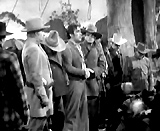  Donald Martin (Dana Andrews) 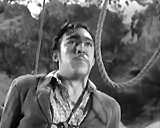 Juan Martínez (Anthony Quinn)  Alva 'Dad' Hardwicke (Francis Ford)  Three Noose Vigilante Hanging |
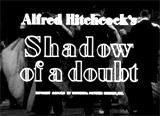
|
In a thrilling concluding scene set on a moving train in the platform between train cars, there was a struggle between Uncle Charlie Oakley (Joseph Cotten) - the "Merry Widow Murderer " - and his young niece Charlie (Teresa Wright). As the train began to move faster, he seized her as she panicked and tried to break away. His face was absolutely monstrous as he advanced on her. She struggled into the space between the cars, while he gripped her mouth and throat and opened the door to fling her onto the tracks. He explained his homicidal intentions: "I've got to do this, Charlie, so long as you know what you do about me." He twisted her around in his tight embrace, as she grappled with him. He lifted her off the ground - her legs dangled in the air. Her black-gloved hand gripped the door handle and then lost its hold. Both watched the passing blur of landscape and tracks (two parallel railway tracks became one), delaying the inevitable plunge into death. Uncle Charles prepared her by waiting for the right moment of lethal speed and exhilaration (and sexual receptiveness), educating her to the monstrous world that he earlier said she must learn - as his twin:
She reversed positions on him, upset his balance and pushed him away - he fell headlong into the path of an oncoming, speeding train on an adjacent track. Her act freed him from his (and her) nightmares and from his curse to kill - she fulfilled her earlier threat ("I'll kill you myself"), aiding her uncle to embrace death. The image dissolved to the one of dancing couples twirling to the Merry Widow Waltz. |
 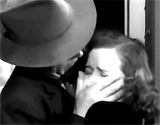 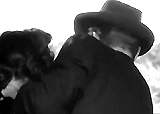 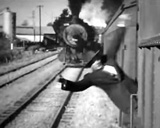 Death of Uncle Charlie |

|
The Song of Bernadette (1943) In the film's conclusion was the moving death of Bernadette Soubirous (Jennifer Jones). Her deathbed was surrounded by other nuns and priests as the last rites were read. Bernadette worried that she wouldn't ever see the Virgin Mary (Linda Darnell) again:
Then, about at the moment of death, she raised her head from the pillow and experienced a final visitation from the Virgin Mary who held out her arms, and smiled. Bernadette responded:
After her death, Father Peyramale (Charles Bickford) stated: "You are now in Heaven and on Earth. Your life begins, O Bernadette." Superimposed bells began to peal from the church tower, and there was a chorus of "Hallelujahs," as the film concluded. |
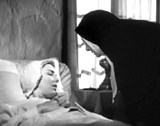   Vision of the Virgin Mary 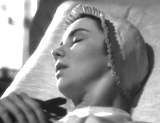 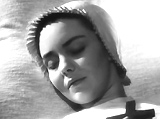
|
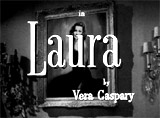
|
In the drama's climactic scene, 'Laura Hunt' murderer Waldo Lydecker (Clifton Webb), in a passionate rage, was about to mortally wound the real Laura (Gene Tierney) with a shotgun. When Laura was left alone, Waldo snuck back into her apartment, past the ticking grandfather clock. He was about to murder Laura (for the second time!) because she had fallen in love with Detective McPherson (Dana Andrews) and was not returning his love. Lydecker removed the shotgun from the clock's base, reloaded the murder weapon, and became startled when he heard his own mellifluous voice on a pre-recorded radio broadcast that Laura played within her bedroom. Lydecker's sick fantasy was echoed in his own poetic broadcast about how Love lasted beyond death:
In her bedroom as Laura prepared to retire, Lydecker broke her out of her reverie and shocked her with his appearance. He vowed to kill her, rather than lose her to McPherson:
He raised his shotgun: "There he is now. He'll find us together, Laura as we always have been and we always should be, as we always will be." His words strongly implied that he intended a murder/suicide. Laura deflected the aim of the shotgun upward as it went off. McPherson broke down the door just in time to save her and have her run and fall into his arms. Waldo was mortally wounded in an exchange of gunfire with the police. A shotgun blast went wild and shattered the face of the grandfather clock. As Waldo was dying and uttered her name ("Goodbye, Laura"), she rushed to his side. The camera rested on the clock as Lydecker's final words were delivered off-screen with a theatrical flourish:
|
 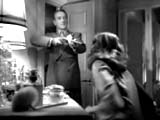 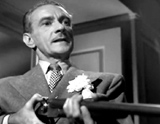 Threatening Laura With a Shotgun 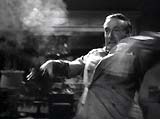 Lydecker Shot Dead 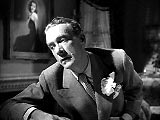 Mortally Wounded: "Goodbye, Laura. Goodbye, my love." 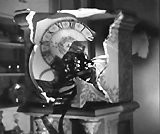 Shattered Clock |
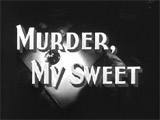
|
In this film noir's twist ending and violent conclusion set in a beach house, Mrs. Helen Grayle/Velma (Claire Trevor) died when shot by her millionaire husband Mr. Grayle (Miles Mander), who reasoned: "I couldn't let her go. I loved her too much." Love-struck ex-con Moose Malloy (Mike Mazurki) reacted to her lifeless body on the sofa:
Mr. Grayle and Moose then exchanged lethal shots as well. Detective Philip Marlowe (Dick Powell) was temporarily blinded by the first gunblast. |
 Death of Helen Grayle/Velma 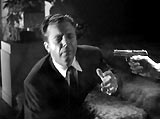 Blinding of Detective Marlowe |

|
Detour (1945) The nightmarish flashback story in the bleak, film-noir classic was cynically narrated, with almost non-stop voice-over, by a world-weary, fatalistic, self-pitying, down-and-out hitchhiker Al Roberts (Tom Neal), while sitting in a tawdry diner in Reno, Nevada. Despicable hitchhiker Vera (Ann Savage) was accidentally strangled by the doomed protagonist with a telephone cord, behind a closed door in their rented Hollywood apartment. It occurred during a vicious argument when the drunken femme fatale threatened to call the Hollywood police station on him.
After she called him a "yellow stinker" and accused him of not being a "gentleman," she ordered him to open up the windows. It was a ploy - she grabbed the phone and raced into the adjoining room where she locked herself in, to carry out her plan. He pulled on the long phone cord extension, which she had inexplicably wrapped around her neck. When she ignored his promise to do anything she asked for, he began yanking on the cord and pulled it as tightly as possibly (with a close-up of his straining fists). Then, he broke down the door and saw her body lying backwards on the bed - reflected in a mirror, with her head hanging off the end. He hung up the phone and then looked around, realizing how incriminating everything looked. Now self-pitying Roberts had another murder to be accounted for, and he knew his fate was sealed as a guilty man:
This was a second disastrous twist of fate for Roberts - signified by the in-and-out of focus shots from his deranged mental state and POV as he looked around the incriminating bedroom.
As he left the Reno, Nevada diner where he had been relating his woeful tale, his voice-over continued with the film's final lines of dialogue:
He imagined his arrest by the Highway Patrol outside the diner (to appease the Hays Code censors of the time). |
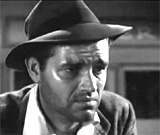   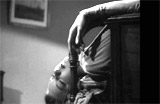 Telephone Cord Strangulation   Roberts - Murderer! 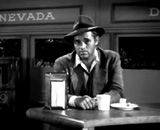  Arrested by the Highway Patrol Outside the Diner |

|
An uncaring, sunglasses-wearing femme fatale Ellen Berent (Gene Tierney) watched from a rowboat as her young, paraplegic brother-in-law Danny Harland (Darryl Hickman) drowned before her in a Maine lake. The scene began with her cheerfully assisting Danny in applying suntan lotion before he slipped into the water from the boat. He asked: "Can I swim all the way across today?" When she asked: "Do you think you can make it?", he assured: "Why sure? I made it three-quarters yesterday and I wasn't a bit tired." She followed in the rowboat, and promised he didn't have to worry about his direction: "I'll keep you on your course." She steered him into the middle of the lake and noted: "You're not making very much progress, Danny. Are you alright?" When he became winded and had a kink in his side, he admitted he was getting tired. She told him to "take it easy," but then pushed him further: "You don't want to give up when you've come so far." When he became exhausted and distressed in the water from severe stomach cramps (after eating a large lunch), Ellen passively watched as he called out: "Help me!" He submerged twice and then disappeared under the surface. She pretended to assist him by diving in, but it was obviously too late. In the film's conclusion, the jealousy-possessed Ellen committed suicide with poison to 'frame' her foster sister Ruth Berent (Jeanne Crain), after her novelist husband Richard Harland (Cornel Wilde) finally walked out on her. |
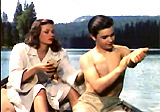 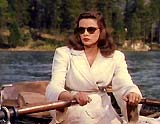  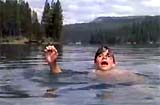
Passively Watching an "Accidental" Drowning |
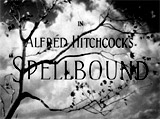
|
Spellbound (1945) In the conclusion of Alfred Hitchcock's superb mystery thriller set in a psychiatric institution, there was a shocking confrontational scene that led to a surprise suicide death. At a Vermont mental hospital-asylum (Green Manors), a new handsome psychiatrist named Dr. Anthony Edwardes (Gregory Peck) had arrived to replace the outgoing director or head of the institution, Dr. Murchison (Leo G. Carroll). At the same time, Murchison was mentoring intellectual, cool-minded Dr. Constance Petersen (Ingrid Bergman), another psychoanalyst. Dr. Petersen engaged in a love affair with the handsome new director of Green Manors, Dr. Edwardes. As their love deepened, she began to become concerned about Edwardes' mental state. He suffered from paranoia, neurosis and memory loss (amnesia), frequently saw disturbing images, including recurring lines on a white background, parallel fork lines on a tablecloth, and sled tracks and patterns on a bedspread. She also began to rationally suspect that Dr. Edwardes was delusional and homicidal, and had murdered the real Dr. Edwardes. As a result of Dr. Petersen's probing, Edwardes admitted that he was an imposter, and expressed fears that he may have killed the real Dr. Edwardes, and then taken his place. He fled from the institution, with Dr. Petersen in pursuit. She encouraged him to use psychoanalysis to discover what really happened. Imposter Edwardes took the name 'John Brown' - and would soon remember that his name was really Dr. John Ballyntine (or "JB") (also Gregory Peck). During dream analysis, Ballyntine described playing blackjack (21) at a casino (with eyes on the walls) with a seven of clubs, a bearded man and a faceless proprietor, including images of a sloping roof, a man with a misshapen wheel, and pursuit by a giant pair of wings - (the sloping roof was tied to JB's memory of his brother's accidental and tragic death by impalement on a spiked fence, when he slid down the roof and accidentally knocked his brother off - killing him on the spiked railing). In the film's plot twist, the parallel lines in the imposter's dreams represented his partial, corrupted memories of a traumatic ski accident at Gabriel Valley that he had witnessed. (He had actually witnessed the murder of the real Dr. Edwardes, his analyst, on the ski slope, but repressed it. Ballyntine inaccurately recalled watching his ski partner fall off a steep precipice and die during a skiing vacation. However, in reality, he was able to stop both of them just in time before plunging over the edge.) When the police arrived on the scene and recovered Edwardes' actual corpse, they discovered a bullet wound in the body's back, and suspected John Ballyntine of murder. Ballyntine was convicted of the murder and sent to prison. In the film's ending, Dr. Petersen realized Murchison's treachery after he said: "I knew Edwardes only slightly. I never really liked him. But he was a good man, in a way, I suppose." He contradicted his earlier statement that they had never met. She immediately knew that if he had known Edwardes, he shouldn't have mistaken the imposter Ballyntine for Edwardes. Motivated by jealousy and not wanting his job stolen, Murchison had used Ballyntine's disabilities to frame him for the murder of Edwardes (there was a bullet in his body, delivered from Murchison's gun in full view of Ballyntine). In his office, Dr. Petersen began to interpret some of JB's dream symbolism. Even before she had stated factual evidence that could convict Dr. Murchison ("There will be no dreams necessary for this case"), he had pulled the murder weapon from his desk, and held it toward her. While threatening her because of her knowledge of his crime, he appeared unworried about the consequences: "The punishment for two murders is the same as for one." She struck back: "You're not going to commit a second murder, Dr. Murchison." He made it clear that he had deadly intentions: "I hadn't planned to, but you're here. You're not leaving." Dr. Petersen cautioned him to not murder her. She asserted that his previous crimes might result in a life sentence or a prison term, but that he would undoubtedly get the death penalty (electric chair) for pre-meditated murder: "A man with your intelligence does not commit a stupid murder. You're thinking you were not mentally responsible for that other crime in the snow. They'll find extenuating circumstances in the state of your health. They'll not execute you for the death of Dr. Edwardes. You can still live, read, write, research, even if you are put away. You're thinking that now, Dr. Murchison." He pointed his gun at her back and tracked her (from his POV) as she stood up and moved toward the exit door. She continued: "If you shoot now, it is cold, deliberate murder. You'll be tried as a sane murderer, convicted as a sane man, and killed in the electric chair for your crime." She announced that she was leaving the room to phone the police. He memorably committed suicide in the conclusion by turning the gun on himself (toward the camera) and pulling the trigger after she left his office and shut the door. It was a shocking first person point-of-view shot, with a fraction-of-a second splash of red color (in the B/W film). |
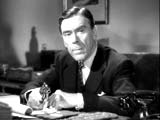 Dr. Murchison (Leo G. Carroll)  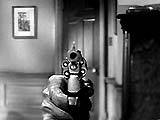 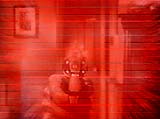 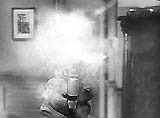 Murder Weapon Pointed at Dr. Constance Petersen (Ingrid Bergman), Then Used For Murchison's Own Suicide |
(chronological by film title) Intro | 1915-1929 | 1930-1933 | 1934-1938 | 1939 | 1940-1942 | 1943-1945 | 1946-1947 | 1948-1949 1950-1952 | 1953-1955 | 1956-1957 | 1958-1959 1960-1961 | 1962-1963 | 1964-1966 | 1967-1968 | 1969-1970 1971 | 1972 | 1973 | 1974 | 1975 | 1976 | 1977-1978 | 1979 1980 | 1981 | 1982 | 1983 | 1984 | 1985 | 1986 | 1987 | 1987 | 1988 | 1989 1990 | 1991 | 1992 | 1993 | 1994 | 1994 | 1995 | 1995 | 1996 | 1997 | 1998 | 1998 | 1999 2000-2001 | 2002 | 2003 | 2004 | 2005 | 2006 | 2007 | 2008 | 2009 | 2010 | 2011 |